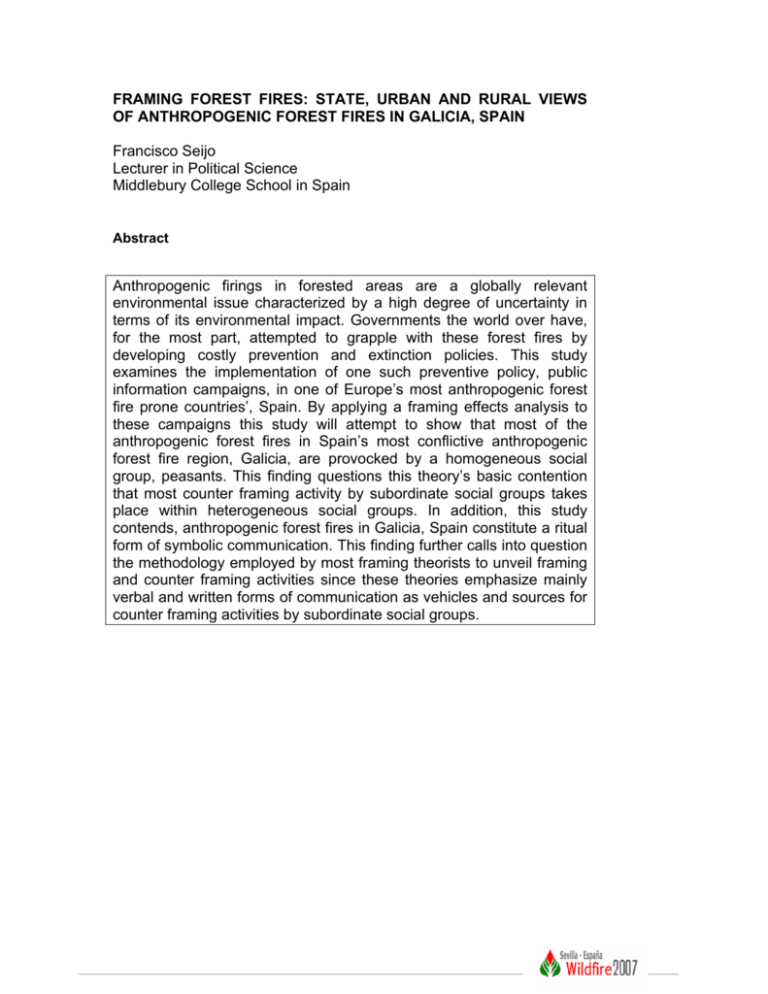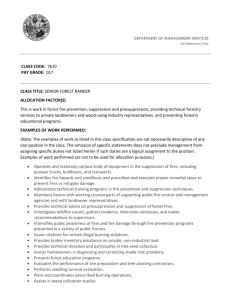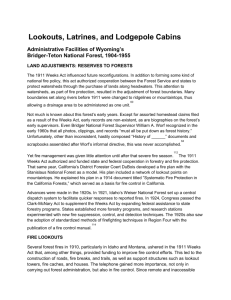Here's the Title1
advertisement

FRAMING FOREST FIRES: STATE, URBAN AND RURAL VIEWS OF ANTHROPOGENIC FOREST FIRES IN GALICIA, SPAIN Francisco Seijo Lecturer in Political Science Middlebury College School in Spain Abstract Anthropogenic firings in forested areas are a globally relevant environmental issue characterized by a high degree of uncertainty in terms of its environmental impact. Governments the world over have, for the most part, attempted to grapple with these forest fires by developing costly prevention and extinction policies. This study examines the implementation of one such preventive policy, public information campaigns, in one of Europe’s most anthropogenic forest fire prone countries’, Spain. By applying a framing effects analysis to these campaigns this study will attempt to show that most of the anthropogenic forest fires in Spain’s most conflictive anthropogenic forest fire region, Galicia, are provocked by a homogeneous social group, peasants. This finding questions this theory’s basic contention that most counter framing activity by subordinate social groups takes place within heterogeneous social groups. In addition, this study contends, anthropogenic forest fires in Galicia, Spain constitute a ritual form of symbolic communication. This finding further calls into question the methodology employed by most framing theorists to unveil framing and counter framing activities since these theories emphasize mainly verbal and written forms of communication as vehicles and sources for counter framing activities by subordinate social groups. Session No.—part of the title—authors’ last names SUMMARY Anthropogenic forest fires are as varied in their casuistic as the ecosystems and human cultures in which they take place (Pyne, 1997). For much of the XXth century forest fires, both of anthropogenic and nonanthropogenic origin, were perceived by foresters as a destructive force that had to be suppressed and abolished, or, more simply put, fought like an enemy in a war (Kohm & Franklin, 1997a: 191). A growing literature on the ecology of fire, emanating both from the professional forestry sector and the social sciences, has gradually revised this traditional paradigmatic outlook towards forest fires by state forest agencies, Two major themes in fire management occurred during [the XXth] century. The first was the development of organized fire protection from 1900 to 1950-that is, the institution building necessary to combat a common “enemy” (see, for eg., Cowan 1961). The second was the evolution of these institutions to reflect varied goals of land management, making our response to fire more complex over the second half of the century (Kohm & Franklin, 1997b: 192). Spain, one of the states most prone to anthropogenic forest firings in Europe, has been no exception to this paradigmatic revision. Though forest fires are still largely seen by the general population as catastrophic events that need to be combatted vigorously, most professional foresters now acknowledge that forest fires are an integral part of the Mediterranean biome and that anthropogenic forest fires once played a crucial role in traditional pre-scientific ecosystem management by the rural population (Seijo, 2005). In fact, the majority of Spain’s anthropogenic forest fires are still, to this day, provoked by the rural population much for the same reasons as in the past. That is; the elimination of excess shrubbery, the preparation of fields Session No.—part of the title—authors’ last names for cultivation, the preparation of soils for future pasture growth, etc. As a consequence of the state’s fire suppression policy, anthropogenic forest fires have also emerged in the past half century as a ritual of political resistance by the peasantry against the Spanish state’s forceful reforestation of the peasants common lands during much of the XXth century (Seijo, 2005). The transformation of Spain’s traditional anthropogenic forest firings into an “enemy”, and subsequently into a ritual of resistance, was brought on by two major historical developments related to the Spanish state’s XXth century forest policy. First, the effort to reforest the countryside with fast growing commercial tree species for use in the timber transformation and paper pulp industries. Second, the massive migration of the peasantry from the countryside to the cities. This latter phenomenon can be, in turn, related, at least in part, to the enclosure of large tracts of peasant common lands to further the state’s reforestation effort (Lopez & Gonzalez, 2002; Seijo, 2005). Both of these developments contributed to the large scale transformation of the traditional ecosystem, where anthropogenic forest fires played an important role in the maintenance of the ecological equilibrium, and, indirectly, to the aggravation of the consequences of anthropogenic forest firings. The introduction of new single specie and age, homogeneous and continuous forest masses resulted in the existing ecosystem in which forest fires are now larger in dimension and more destructive than in the past. This development, coupled with the gradual abandonment of agricultural and forest lands by the peasantry, has also contributed to the accumulation of more vegetational fuel in the countryside. Indirectly, the transformation of the traditional ecosystem, resulting from the state’s intervention in the countryside during the XXth century, also provocked a reordering of economic and social priorities in the forest and created the need for the Session No.—part of the title—authors’ last names maintenance of costly forest fire prevention and extinction policies to protect the new state created forests from traditional anthropogenic forest firings. Its within the social context of this ancestral, culturally condoned, use of fire by peasants, then, that Spanish foresters have attempted to curtail anthropogenic forest firings and establish a forest fire free countryside to further their own forest policy goals. Spain’s public information campaigns against anthropogenic forest fires began in 1940, along with the first large scale reforestation plans, and have continued with only brief interruptions to this day. The content of these campaigns has, of course, varied significantly through the years as have their slogans, the technological means used to diffuse the messages, the audiences intended to be the recipients of the message and the scientific knowledge base on the ecology of fire of the foresters designing these campaigns. Two “framings” of the anthropogenic forest fire issue, however, have remained constant throughout the years in the state’s public information campaigns. First, the vision of forest fires as an “enemy” that needs to be combatted vigorously. Second, the popularization of the largely inaccurate view, as presented in the campaigns, that most of the anthropogenic forest fires in Spain are caused by negligences or accidents related to the recreational activities of the urban population in the countryside. This study will attempt to explain, through a framing effects approach, how anthropogenic forest fires were framed by the state as an “enemy” through the public information campaigns it conducted starting in the 1940s. It will also attempt to show the effects of these framing activities on the two social groups exposed to them, the urban and the rural population, and how a successful counter frame emerged among a part of the rural population as a result of ritual resistance in the shape of intentional forest fires against the state’s reforestations. These two arguments call into question Session No.—part of the title—authors’ last names some important assertions of current framing effects theory which postulates that counter framing activities are most likely to take place among heterogeneous social groups, leading this theory to expect in the Spanish case that the urban population would emerge as the most resistant to the state’s framing activities, and that counter framing is most likely to occur as a result of conversations between these same heterogeneous social groups, rather than through symbolic communication (ie. ritual) among homogeneous groups (ie. the peasantry). From a policy perspective this finding has important implications regarding the effectiveness of the traditional communication strategy by the state. The campaigns, have had a framing effect where it is less needed, that is, among the urban population. State campaigns have diffused the message that forest fires are for the most part provocked by negligent urban campers. This is simply not the case from a factual point of view. In addition, the prevailing state frame, which presents forest fires as an “enemy” that need to be suppressed, may also prove counter-productive in the new paradigmatic scenario that is emerging among foresters concerning forest fires. Forest fires are not an “enemy”, according to the latest knowledge base, but one among many management tools that an adequate administration of Mediterranean ecosystems needs. Therefore, it would seem that the state’s public information campaigns need to adapt to the new reality.






